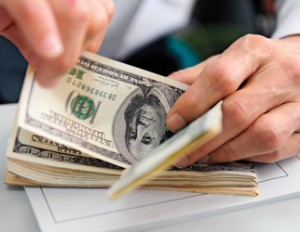It’s no time to hedge your bets
When our dollar was rising, some hedged currency exposure. But what if the greenback is strengthening?
Advertisement
When our dollar was rising, some hedged currency exposure. But what if the greenback is strengthening?
 To hedge or not to hedge? It’s the question investors ask when buying U.S. stocks. In the last few years, it made sense to protect yourself from currency fluctuations as the loonie floated up from US$0.81 in January 2009. The outlook for the Canadian dollar, though, isn’t as rosy going forward.
Karen McRae, senior vice president at Mackenzie Investments, points out that when commodity prices fall, so does the dollar. At US$0.97, the loonie is trading at historically high levels. If global stock markets sink, the U.S. dollar tends to strengthen and hedging may not look so attractive.
In fact, McRae says there may never be a good time to hedge. “The U.S. dollar has a negative correlation with equity markets because of its safe haven status, so having exposure can be a good source of diversification.”
She’s also found that not hedging tends to provide lower return volatility over the long-term, though only with U.S. investments. Hedging 50% of international assets minimizes overall portfolio risk, she says.
Certified financial planner Fred Kirby also thinks foreign currency can be a good diversifier. He thinks it likely the Canadian dollar will fall in the short-term but isn’t willing to avoid hedging completely. Most portfolios should have between 25% and 35% exposure to U.S. and international stocks and those currencies. Stay in that range and there’s no need to hedge.
However, any investor with more than 35% in non-Canadian equities should hedge, Kirby says. Otherwise too much of your money will be dictated by the currency market. “Currency exposure adds a hidden asset class that is generally not correlated with the equity markets,” he says. “But one must guard against overweighting that exposure.”
Protecting against currency fluctuations is costly. Hedging the S&P 500 costs investors about 0.5% a year, or about 15% more in fees. If our dollar falls further, and you’re hedged, not only will you not be taking advantage of the appreciating greenback, you’ll be losing extra on fees too. Of course, if the loonie drops and then rises again, those additional costs could be worth it. “It’s all about balance,” Kirby concludes.
To hedge or not to hedge? It’s the question investors ask when buying U.S. stocks. In the last few years, it made sense to protect yourself from currency fluctuations as the loonie floated up from US$0.81 in January 2009. The outlook for the Canadian dollar, though, isn’t as rosy going forward.
Karen McRae, senior vice president at Mackenzie Investments, points out that when commodity prices fall, so does the dollar. At US$0.97, the loonie is trading at historically high levels. If global stock markets sink, the U.S. dollar tends to strengthen and hedging may not look so attractive.
In fact, McRae says there may never be a good time to hedge. “The U.S. dollar has a negative correlation with equity markets because of its safe haven status, so having exposure can be a good source of diversification.”
She’s also found that not hedging tends to provide lower return volatility over the long-term, though only with U.S. investments. Hedging 50% of international assets minimizes overall portfolio risk, she says.
Certified financial planner Fred Kirby also thinks foreign currency can be a good diversifier. He thinks it likely the Canadian dollar will fall in the short-term but isn’t willing to avoid hedging completely. Most portfolios should have between 25% and 35% exposure to U.S. and international stocks and those currencies. Stay in that range and there’s no need to hedge.
However, any investor with more than 35% in non-Canadian equities should hedge, Kirby says. Otherwise too much of your money will be dictated by the currency market. “Currency exposure adds a hidden asset class that is generally not correlated with the equity markets,” he says. “But one must guard against overweighting that exposure.”
Protecting against currency fluctuations is costly. Hedging the S&P 500 costs investors about 0.5% a year, or about 15% more in fees. If our dollar falls further, and you’re hedged, not only will you not be taking advantage of the appreciating greenback, you’ll be losing extra on fees too. Of course, if the loonie drops and then rises again, those additional costs could be worth it. “It’s all about balance,” Kirby concludes.
Share this article Share on Facebook Share on Twitter Share on Linkedin Share on Reddit Share on Email